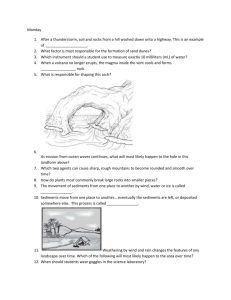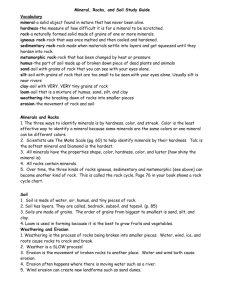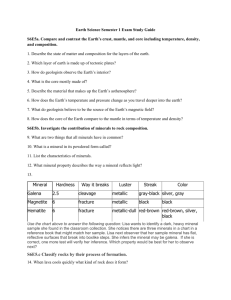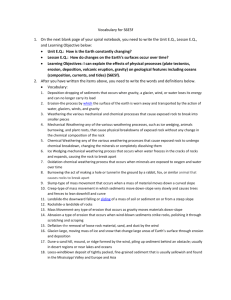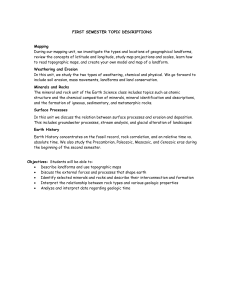SOL Review 2
advertisement
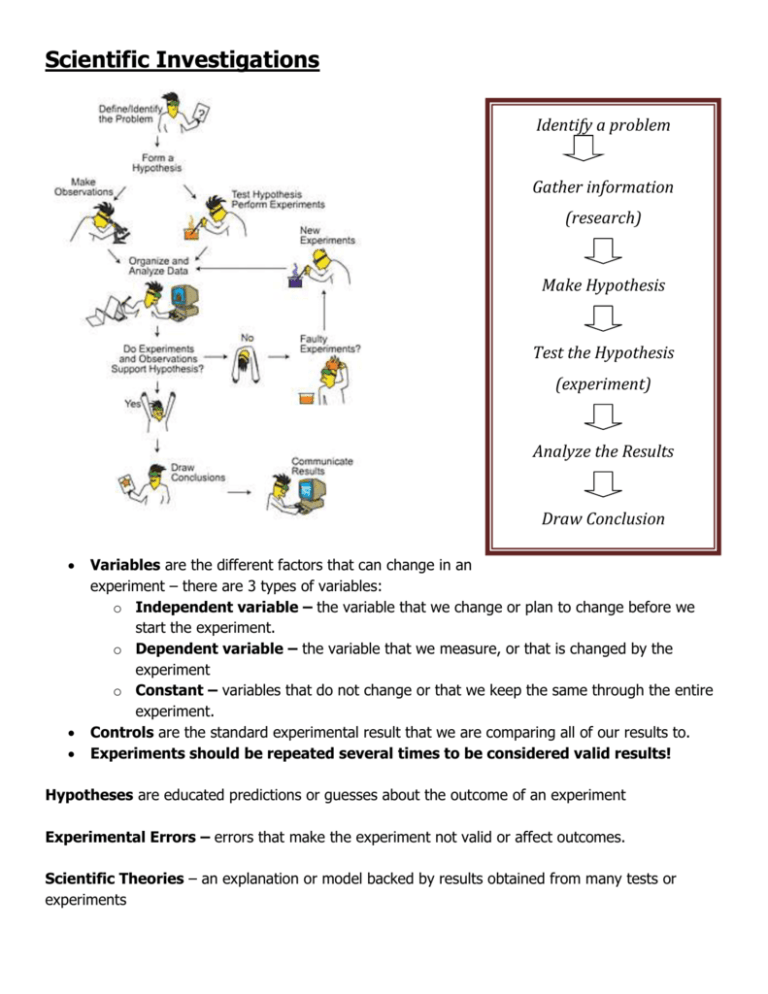
Scientific Investigations Identify a problem Gather information (research) Make Hypothesis Test the Hypothesis (experiment) Analyze the Results Draw Conclusion Variables are the different factors that can change in an experiment – there are 3 types of variables: o Independent variable – the variable that we change or plan to change before we start the experiment. o Dependent variable – the variable that we measure, or that is changed by the experiment o Constant – variables that do not change or that we keep the same through the entire experiment. Controls are the standard experimental result that we are comparing all of our results to. Experiments should be repeated several times to be considered valid results! Hypotheses are educated predictions or guesses about the outcome of an experiment Experimental Errors – errors that make the experiment not valid or affect outcomes. Scientific Theories – an explanation or model backed by results obtained from many tests or experiments Scientific Law – a rule that describes the behavior of something in nature Read the graduated cylinder by looking at the bottom of the depression, or miniscus Density Mass/Volume May have to use water displacement to determine volume of an irregularly shaped substance Determine the volumes of these 2 objects. In each case, you will need to determine the increments of measure the Cylinder is giving you… Maps and Landforms Landforms o Plains – large flat areas – ex. Great Plains and Coastal Plain of Virginia o Plateaus – raised areas that are flat on top – uplifted by earth forces – ex. Colorado Plateau, and Cumberland Plateau of Virginia o Folded Mountains – created by forces pushing in from the sides. – ex. Rocky Mountains, and the Appalachian Mountains of Virginia (much older than the Rockies) o Upwarped Mountains – created by lifting forces deep under the earth. Often the tops of the ridges erode into peaks – ex. Adirondack Mountains of NY and Black Hills of SD o Fault Block Mountains – created by faults as they move in opposite directions. Ex. Grand Tetons in Wyoming and the Sierra Nevadas in California o Volcanic Mountains – formed from volcanic activity in the earth.—ex. Mount St. Helens in Washington. Latitude/Longitude o Latitude lines Parallel to each other horizontally around the earth Their measurements will be from 0° to 90°North of the equator, and 0° to 90° South of the equator. 0° Latitude is the Equator 90° N is the North Pole 90° S is the South Pole From the North Pole to the South Pole there are a total of 180° of Latitude o Longitude lines Run vertically up and down, and meet at the Poles. Their measurements will be from 0° to 180° East of the Prime Meridian and 0° to 180° West of the Prime Meridian. 0° Longitude is the Prime Meridian 180° Longitude is the International Date Line (IDL) Travel west across the IDL, you move your calendar forward one day Travel east across the IDL, you move your calendar backward one day There are a total of 360° of Longitude o Both Longitude and Latitude lines can be further broken down into Minutes and Seconds as measurement units. There are 60 “minutes” between 2 consecutive Longitude lines. POINT LOCATION A lat. 5° 59' 45" N; long. 71° 00' 45" W B lat. 5° 59' 09" N; long. 71° 01' 00" W C lat. 5° 59' 30" N; long. 71° 00' 00" W Practice your Latitude and Longitude readings here… What are D, E, and F? Topographical Maps – models the changes in elevation of the Earth. Contour lines – lines on the map that connect points of equal elevation Index contours – lines that are clearly marked with their elevation Contour Interval – difference in elevation between adjacent (side-by-side) contour lines Rules o Contour lines close around hills and basins. Basins will usually have small marks pointing inward to indicate a depression. o Contour lines never cross o Contour lines that are close together indicate a steep slope. Contour lines very far apart indicate much flatter land. o Contour lines form Vs that point upstream when they cross streams. Map Scale – the ratio between the distance on the map and the distance on Earth o If no units are expressed, the ratio has the same units on both sides of the ratio o Example 1:24,000 means 1 unit on the map equals 24,000 units on the Earth. Units may be inches, cm, mm, etc. What is the contour interval in this map? Basin Minerals Characteristics: A naturally occurring, inorganic, solid with a definite chemical composition and a crystalline structure. Physical Properties: Hardness: how easily a mineral can be scratched – Compared using the Moh’s Scale of Hardness Color: easily determined, least useful property for identification Luster: way a mineral reflects light (shines) Metallic – like a metal Nonmetallic – dull, glassy, silky, earthy, etc. Streak: color of a mineral in powdered form Tested by rubbing the mineral against an unglazed porcelain tile called a streak plate Cleavage: Breakage pattern of a mineral Breaks along a smooth flat surface Fracture: Breakage pattern of a mineral Breaks with rough or jagged uneven surfaces Specific Gravity: The ratio of its weight compared to an equal volume of water Tested in field using the heft test – which one of equal size feels heavier Magnetism: acts like a magnet Effervescence: fizzes with acid Mineral Uses: Ores – a mineral that is useful and profitable such as pyrite, magnetite, hematitie, galena, graphite, etc. Gems – a mineral that is rare and beautiful – examples: diamonds, ruby, and sapphires Rocks Rock Cycle describe how one type of rock changes into another Rocks: Differ From minerals Are a mixture of rock fragments, minerals and/or organic matter Igneous rocks: Form from the cooling and crystallization of magma/lava Based on texture: o Intrusive: Forms inside earth from magma Large mineral grains (coarse-grained texture) Examples - Granite o Extrusive: Forms on or near earth’s surface Small mineral grains (fine-grained texture) Examples – Pumice, Obsidian, Basalt Based on composition: o Granite: Light colored and Less dense Silica rich Examples - Granite o Basalt: Dark and dense Low silica content / rich in magnesium and iron Examples – Basalt, Metamorphic Rocks Form from heat and pressure applied to pre-existing rocks (process called metamorphism) Types: o Foliated: Flattened mineral grains Banding and/or layering Examples: Gneiss, Slate, Schist o Nonfoliated: Increased mineral grain size Not layered Examples: Marble and Quartzite Sedimentary Rocks Formed by the compaction (pressing) or cementation (glueing) of sediments or by chemical precipitation or evaporation Types: o Clastic (Detrital): Made of rock / mineral fragments Examples: sandstone and shale, conglomerate (rounded sediments) and breccia (angular sediments) o Chemical: Formed from precipitation within a solution or evaporation of a solution Examples: Limestone o Organic: Formed from the remains of once living organisms Examples: Coal, Coquina, Fossil-rich Limestone Weathering & Soil Weathering: the process by which rocks are broken down by action of water, air and organisms into sediments. Sediments: are pieces of rocks and organic matter that is classified by size not composition. Clay - Silt - Sand - Pebble - Boulder Types of Weathering Mechanical – o Breaks down rocks by physical processes without a chemical change o Examples: rootpry, ice wedging (frost action), burrowing animals Chemical – o Chemical reactions cause mineral sin rocks to dissolve or change o Examples: natural acids, oxidation (rust), plant acids o Main agent = water The rate of weathering is affected by: Climate (chemical weathering = tropical climate) Rock type and composition Amount of precipitation Soil – a mixture of sediment derived from weathered rock mixed with organic matter Humus – the dark-colored decaying organic matter Soil Profile – all the layers of soil Horizon – each individual layer of the soil profile Leaching – the process where dissolved minerals where carried by water from one horizon to the next Litter – mixture of twigs, leaves and other organic matter than will eventual decay to form humus Soil Profile Horizon A: (topsoil) most evolved, darkest, contains litter, humus, plant roots, burrowing animals, finest sediments, plant nutrients. Horizon B: (subsoil). Little humus, lighter color, some plant roots, minerals from leaching. C Horizon: partially weathered rock. Bottom Layer. Bedrock: below C-horizon Soil Loss – humans, deforestation, poor farming practices, overgrazing and construction have all lead to soil loss Methods to Reduce Soil Loss – Planting vegetation Crop rotation No-till Farming Contour Farming Erosion Erosion – The transportation of sediment by wind, water, ice or gravity Deposition – The dropping of transported sediment in a new location Erosion by Gravity (Mass Movements / Mass Wasting) Erosion down slopes usually due to heavy rain or tectonic activity Types: o Slump: When a mass of matter slips down leaving a curved scar behind Slow process o Creep: movement of sediments due to freezing and thawing Causes posts and fences on hills to lean Extremely slow o Rockslides: Rocks falling down hill knocking other rocks loose along the way Leaves a pile of rocks at bottom of hill Fast process o Mudflows: When heavy rains turn dry soil into a thick muddy paste that moves downhill Destroys anything in its path Leaves cone-shaped deposit Extremely fast Glacial Erosion Glaciers a large mass of moving ice and snow Erodes by abrading (bulldozings) or plucking Plucking: similar to ice wedging – boulders and large sediments are plucked from the bottom of glacier due to freezing and thawing of meltwater Deposition of material Till – o deposited by glacier itself o Unsorted Outwash – o Deposited by glacial meltwater o Sorted by size Wind Erosion Deflation – the erosion of fine sediment, leaving behind the larger particles Abrasion – sediment is blown against other rocks – Causes rocks to become pitted and polished (like sandblasting) Deposition: Loess – thick, light colored deposits of fine sediment Dunes – sediments piling around an object such as a bush or large rock Natural Resources Energy – the ability to cause change Many of our resources are used to create energy Non-Renewable Cannot be easily formed – may take millions of years to replace Fossil Fuels Resources created from the remains of plants and animals which were buried millions of years ago. The Reserve is the amount of the fuel that can be extracted from the Earth at a profit using current technology. o Coal A sedimentary rock formed from compacted and transformed plant material The most abundant fossil fuel in the world May be removed by strip mining or underground mining. Strip mining is very damaging to the environment. One of Virginia’s most important resources Peat – Decayed plant material. The first step in Coal formation Time, heat and pressure form the next layer of this sedimentary rock. Lignite – Brown Coal. Soft, about 50% Carbon. Produces a fair amount of smoke when burned. Time, heat and pressure form the next layer of this sedimentary rock. o Bituminous – Black Coal. Brittle. Majority of the coal burned is bituminous. Smoky and contains sulfur which is an environmental pollutant. Time, heat and pressure form the next layer of this sedimentary rock. Anthracite – Hard Coal. Highest amount of Carbon. Relatively clean burning compared to other coals. Oil Thick, black liquid formed from the buried remains of microscopic marine organisms A Hydrocarbon May be refined and used in many different ways including heating, gasoline, lubricants and manufacturing. o Natural Gas A clear gas formed from the buried remains of microscopic marine organisms A Hydrocarbon Nuclear Energy Created from the splitting of atoms of heavy elements to create energy Nuclear waste requires safe storage for 10,000 years before it can reenter the environment Inexhaustible Energy sources Solar o Energy from the sun o Advantage - Clean and limitless o Disadvantage - doesn’t work on cloudy days. Solar cells are not yet very efficient. Wind o Uses wind farms – large collections of wind turned turbines o Advantage - Clean and free o Disadvantage – requires large areas with constant wind sources. May kill or injure wildlife. Hydroelectric o Dams trap water and then create electricity as the water turns turbines. o Advantage - Relatively clean and renewable o Disadvantage – Dams can change waterways, create erosion, and flood out wildlife Geothermal Energy o Takes advantage of underground magma to heat water. Steam is then used to make electricity. o Requires a source of water Renewable Energy Sources Biomass – energy obtained by burning organic material, including wood, alcohol, and garbage. Wood is the most widely used biomass. Burning it may create pollution, and it requires replanting of forests to be sustainable. Alcohol (Ethanol) can reduce oil use and is efficient, but requires a source, such as corn Garbage can be burned to create a lot of energy, and saves landfill space but may pollute the air. Mineral Resources Ores are deposits where minerals exist in high enough concentrations to be mined at a profit. Refining is the extraction of a useful substance from an ore. Smelting is a chemical process used to remove impurities from ore. Heat may also be used. These processes require energy from some type of fuel, and may create leftover toxic materials. Minerals may be used for industrial uses or building materials. Virginia’s Top Mineral Resources include Hydrology Hydrological Cycle (Water Cycle) o Evaporation – liquid water turns into a gas (water vapor) o Transpiration – evaporation of water from plants o Condensation - cooling and condensing of water vapor into liquid = cloud formation o Precipitation – clouds become saturated and water is returned to the surface through rain, snow, sleet or hail o Runoff – water flowing on the ground o Infiltration – water soaking into the ground to become groundwater. * The Sun is the source of all energy for this cycle. Factors that affect runoff: Amount of precipitation Time length that precipitation falls Type of rock Amount of vegetation Slope of land Types of Water Erosion: Rill erosion – Gully erosion – Sheet erosion – water erosion not in a channel River Development: Young – Rapid, V-shaped bottom, erodes bed (bottom), waterfalls and rapids, mountainous areas Mature – Swift flowing, erodes bed and banks (sides), meanders and flood plains start to develop Old – Slower, erodes banks, well developed meanders and broad flat flood plains, oxbow lakes Oxbow Lakes – cutoff meanders Stream Erosion: Solution Load – materials dissolved and carried downstream Suspension Load – smaller particles carried with in the stream column Bed Load – larger particles are rolled and bounced along the bed (bottom) of the stream. Stream Deposition: Larger, rounder, denser particles drop and settle to the bottom Erosion along a stream: Deltas and alluvial fans are deposits that occur when the river velocity (speed) slow downs Deltas form at the mouth of the river and alluvial fans form as a young stream flows from the mountainous areas onto flatter land. Drainage Basin (Watershed) - land area that drains into a major river Groundwater System Permeable – water can flow through Impermeable - water cannot flow through Aquifers – permeable rock layer sandwiched between two impermeable layers that transmits water freely Springs – form where the water table meets the surface Both are replenished by infiltration of groundwater Geysers – erupting columns of gas and water Karst Topography Cave Formation – water enters into the ground and becomes slightly acidic (carbonic acid) – in passes through limestone or another carbonate rock layer. The acidic water dissolved the minerals in the rock and leaves an opening or void. Water dripping through the cave produces cave formations such as stalagmites and stalactites. Stalagmites – are found on the ground Stalactites – are on the ceiling Columns – connect the ceiling to the ground If the roof of the cave collapses a sinkhole forms. Oceanography Salinity: Measure of the amount of salts in seawater 3.5 % or 35 ppt Ocean Currents: Surface Currents – o Caused by wind o Turned by the Coriolis Effect o Turn CW in the northern hemisphere o Turn CCW in the southern hemisphere o Warm currents flow from equator along eastern coasts of continents o Cold currents flow from the poles along west coasts of continents Density (Deep Water) Currents – o Caused by differences in temperature &/or salinity o Mix the deep waters of the ocean Upwellings – strong winds blow parallel to the coast pushing the warm water away from the shoreline allowing the cold nutrient rich water to rise from below – good fishing grounds Longshore Currents – o produced when waves strike the shore at an angle o responsible for transportation of large amounts of sediment along the shoreline Rip Currents – narrow current flowing out to sea produced when longshore current is stronger than the incoming waves Turbidity Current – density current in which sediment-rich water flows along the seafloor along the continental slope to the ocean basin Life Processes: Photosynthesis – Take in sunlight and CO2 and releases O Respiration – take in O2 and releases CO2 Chemosynthesis – Uses S and N compounds to make energy Ocean Life: Plankton – floaters Nekton – free swimmers Benthos – bottom dwellers Waves: Parts of a wave Water molecule movement in a wave Tides: Tidal Range – difference in height between high and low tide Spring Tides – High tide higher than normal Low tide lower than normal Great tidal range Full and new moon Neap Tides – High tide lower than normal Low tide higher than normal Small tidal range 1st and 3rd Quarter Moon Phases Shoreline Features: Guyot – flat-topped seamount Ocean Trench – formed when two plates collide and one is forced (or subducted) under another) Mid-Ocean Ridge – formed when two plates separate and magma/lava rises to form new seafloor
